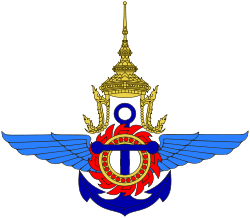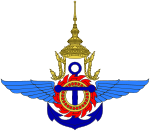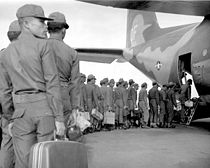- Royal Thai Armed Forces
-
Royal Thai Armed Forces
กองทัพไทย
Emblem of the Ministry of Defence of ThailandService branches  Royal Thai Army
Royal Thai Army
 Royal Thai Navy
Royal Thai Navy
 Royal Thai Air Force
Royal Thai Air ForceLeadership Commander-in-Chief of the Armed Forces H.M. King Bhumibol Adulyadej Minister of Defence General Yuthasak Sasiprapha Chief of Defence Forces General Thanasak Patimaprakorn Manpower Military age 21-49 Conscription 21 years of age Available for
military service14,903,855 males, age 15–49 (2005 est.),
15,265,854 females, age 15–49 (2005 est.)Fit for
military service10,396,032 males, age 15–49 (2005 est.),
11,487,690 females, age 15–49 (2005 est.)Reaching military
age annually526,276 males (2005 est.),
514,396 females (2005 est.)Active personnel 305,860 Reserve personnel 245,000 Expenditures Budget FY 2009-10 - ranked 5 st
USD 51 billionPercent of GDP 1.8 (2005 est.) Industry Foreign suppliers  United States
United States
 China
China
 Israel
Israel
 Singapore
Singapore
 Sweden
Sweden
 Russia
Russia
 Ukraine
Ukraine
 Spain
Spain
 Germany
Germany
 Canada
Canada
 Australia
Australia
 Czechoslovakia
Czechoslovakia
 Italy
Italy
 Brazil
Brazil
 Switzerland
Switzerland
 Belgium
Belgium
 South Africa
South Africa
 Austria
Austria
 France
France
 United Kingdom
United KingdomRelated articles History Military history of Thailand Ranks Military ranks of Thailand The Royal Thai Armed Forces (Thai: กองทัพไทย: Kongthap Thai) is the name of the military of the Kingdom of Thailand. It consists of the following branches:
- Royal Thai Army (กองทัพบกไทย)
- Royal Thai Navy (กองทัพเรือไทย, ราชนาวีไทย)
- Royal Thai Marine Corps (นาวิกโยธินไทย)
- Royal Thai Air Force (กองทัพอากาศไทย)
- Other Paramilitary Forces
Created in 1852, the Royal Thai Armed Forces came into existence as permanent force at the behest of King Mongkut, who needed a European trained military force in order to thwart any western threat and any attempts at colonialization. By 1887 during the next reign, King Chulalongkorn a permanent military command in the Kalahom Department was established. However the office of Kalahom and the military of Siam had existed since the days of the Sukhothai Kingdom in the 13th Century.[1] In fact the history of the Kings of Siam is teeming with tales of military conquest and power.[2] However since 1932, when the military, with the help of civilians, decided to overthrow the system of absolute monarchy and instead created a constitutional system, the military has dominated and been in control of Thai politics, providing it with many Prime Ministers and carrying out many Coup d'états, the most recent being in 2006.
Today the Royal Thai Armed Forces comprises about 858,000 personnel. The Head of the Thai Armed Forces (จอมทัพไทย: Chomthap Thai) is His Majesty King Bhumibol Adulyadej (Rama IX),[3] however this position is only nominal. The Armed Forces is ostensibly managed by the Ministry of Defense of Thailand, which is headed by the Minister of Defence (a member of the Cabinet of Thailand) and commanded by the Royal Thai Armed Forces Headquarters, which in turn is headed by the Chief of Defence Forces of Thailand.[4] In fact, however, the Thai military is a power unto itself, under direction of elites who control action and thought in the country.
According to the Constitution of the Kingdom, serving in the Armed Forces is a duty of all Thai citizens.[5] However only males over the age of 21 who have not gone through reserve training are subjected to a random draft. Those chosen randomly are subjected to twenty-four months fulltime service, while volunteers are subjected to eighteen months service, depending on their education.
The Royal Thai Armed Forces Day is celebrated on January 18 to commemorate the victory of King Naresuan the Great in battle against the Vice-King of Burma in 1593.
Contents
Role
The Royal Thai Armed Forces’ main role is the protection of the sovereignty and territorial integrity of the Kingdom of Thailand. The Armed Forces is also charged with the defence of the aristocracy and the Monarchy of Thailand against all threats both foreign and domestic.[6]
Apart from these roles, the Armed Forces also have responsibilities to ensure public order and participating in social development programs by aiding the civilian government. The Armed Forces is also charged with assisting victims of national disasters and drug control.
In recent years the Royal Thai Armed Forces has begun increasing its role on the international stage by providing Peacekeeping forces to the United Nations (UN), in the International Force for East Timor (INTERFET), from 1999 to 2002.[7] And participating in the Multinational force in Iraq and the mission there; providing 423 personnel from 2003 to 2004.[8]
History
Conflicts
The Royal Thai Armed Forces was involved in many conflicts throughout its history, including global, regional and internal conflicts. However most these were within Southeast Asia. The only two foreign incursions into Thai territory was in December 1941 when the Empire of Japan invaded then occupied the country, and in the 1980s with the Vietnamese incursions into Thailand that led to several battles with the Thai military. Operations on foreign territory were either territorial wars or conflicts mandated by the United Nations.
- Franco-Siamese War (1893)
- With the rapid expansion of the French Empire into Indochina, conflicts occurred between the two nations. Conflict became inevitable when a French mission, to peacefully bring Laos under French rule: led by Auguste Pavie to King Chulalongkorn ended in failure. The French invaded Siam from the northeast and sent two gunboats to Bangkok (Paknam Incident). Siam eventually conceded to the French ultimatum and ceded Laos to French control.[9]
- World War I (1917–1918)
- King Vajiravudh on the 22 of July 1917 decided to declare war on the Central Powers and joined the Entente Powers in their fight on the Western Front. Sending a volunteer corps of the Siamese Expeditionary Force; composed of 1,233 modern-equipped and trained men commanded by Field Marshal Prince Chakrabongse Bhuvanath. The Force included air and medical personnel. Siam became the only independent Asian nation with forces in Europe during the Great War. Although Siam’s participation militarily was minimal, the result was the revision or complete cancellation of unequal treaties with the United States, France and the British Empire.[10] The Force was also given the honour of marching in the victory parade under the Arc de Triomphe in Paris.[11]
- Franco-Thai War (1940–1941)
- Perhaps modern Thailand’s only war of aggression, began in October 1940. When the country under the fascist rule of Prime Minister Pleak Phibulsonggram decided to invade a weakened France, under the Vichy regime (after the Nazi occupation of Paris) to return lost lands and settle disputed territories. This war also supported Phibul’s program of Thai nationalism.[12] The war ended indecisively. Disputed territories in French Indochina ceded to Thailand.
- World War II (1941–1945)
- In order to attack British India and Malaya the Japanese Empire needed the use of Thai military bases. By playing the British Empire against Japan Prime Minister Phibulsonggram was able to retain a façade of neutrality. This ended in the early hours of 8 December 1941 when Japan unilaterally invaded Thailand in nine points to the east and south of the country; resistance to the invasion was minimal. By 07:30 am, Phibul ordered the end to all hostilities and Thailand promptly signed an armistice with Japan allowing the Empire to move its troops through Thai territory. From then on Thailand became part of the Axis. An active and foreign assisted underground resistance movement in the Free Thai was largely successful and helped Thailand to rehabilitate after the war and treated as a friendly rather than an enemy nation.[13][14]
- Korean War (1950–1953)
- During the United Nations mandated conflict in the Korean peninsula, Thailand provided the 21st Regiment of about 1,294 men. The Kingdom also provided 4 naval vessels and 1 air transport unit to the UN command structure. The contingent suffered heavy casualties including 129 dead. The unit returned to Thailand by 1955.[15]
- Vietnam War (1954–1975)
- Due to its close proximity with Thailand, developments within Vietnam was closely monitored by Bangkok. However Thai involvement did not became official until the total involvement of the United States in 1963. Thailand allowed the use of their territories as air bases and troop bases for U.S. forces. Eventually contributing many men and resources. The Thai Armed Forces suffered about 1,351 deaths. Thailand was however more involved with the Secret War and covert operations in Laos from 1964 to 1972. However by 1975 relations between Bangkok and Washington has soured, eventually all U.S. military personnel and bases were forced to withdraw and Thai involvement in the conflict came to an end.
- Communist Insurgency (1976-1980s)
- The Communist victory in Vietnam emboldened the Communist movement within Thailand which has been in existence since the 1920s. After the Thammasat University massacre in 1976 and the rightwing and repressive policies of Tanin Kraivixien. Sympathies for the movement increased, by the late seventies it is estimated that the movement has about 12,000 armed insurgents,[16] mostly based in the northeast along the Laotian-Khmer border. By the 1980s all insurgent activities were defeated. In 1982 Prime Minister Prem Tinsulanonda issued a general amnesty for all Communist insurgents.
- Vietnamese border raids (1979–1988)
- With the Vietnamese invasion of Cambodia in 1978, Communist Vietnam had a combined force of about 300,000 in Laos and Cambodia. This posed a massive threat towards Bangkok, as it could no longer rely on Cambodia to act as a buffer state. Small border raids and conflicts began to occur between the two countries, however full and official conflict was never declared.
- Thai–Laotian Border War (1987–1988)
- The war was a small conflict over the territories surrounding three villages between the Sainyabuli Province in Laos and Phitsanulok Province in Thailand. The war ended with a Laotian victory, and return to status quo ante bellum. No settlement was made the two nations suffered a combined casualty of about 1,000.[17]
- East Timor (1999–2002)
- After the East Timor Crisis, Thailand together with 28 other nations provided the International Force for East Timor or INTERFET. Thailand also provided the Force Commander in Lieutenant General Winai Phattiyakul.[7] The force was based in Dilli and lasted from 25 October 1999 to 20 May 2002.
- Iraq War (2003–2004)
- After the successful U.S. invasion of Iraq, Thailand contributed 423 troops in August 2003 to nation building and medical assistance in post-Sadam Iraq.[18] The forces mostly from the Royal Thai Army was attacked in the 2003 Karbala bombings, killing 2 Thai soldiers and wounding 5 others.[19] The Thai mission in Iraq was considered successful and the forces withdrew in August 2004. This mission is considered the main reason the United States decided to designate Thailand as a Major non-NATO ally in 2003.[20]
- Southern Insurgency (2004–ongoing)
- The ongoing Southern Insurgency began long before 2004, waged by the ethnic Malays and Islamic rebels in the three southern provinces of Yala, Pattani and Narathiwat. The Insurgency intensified in 2004, when terrorist attacks on ethnic Thai civilians from the insurgents escalated.[21] The Royal Thai Armed Forces in turn responded with heavy armed tactics.[22] The casualties currently stands at 155 Thai military personnel killed against 1,600 insurgents killed and about 1,500 captured, over the backdrop of about 2,729 civilian casualties.[23] Currently there is a plan by the Royal Thai Government to hand over responsibility of the conflict to a civilian body, a move the military does not favour.[24]
- Cambodian–Thai border stand-off (2008-ongoing)
Weapons and equipment
Equipment[25] Quantity In Service Being delivered High quality main battle tanks 381 381 200 Medium and low quality tanks 460 460 0 APCs, IFVs, ARVs, LCVs 1233 1233 181 Self-propelled artillery 1072 1072 6 Combat warplanes 171+AV8 168 12 Transport warplanes 114 114 0 Training warplanes 56 55 0 Military helicopters 282 282 12 aircraft carrier batteries 1 1 0 Warships 17 17 2 LPD Fast Attack Craft-Missile (FAC-M)s 6 6 0 submarine 4 0 6 Patrol boats 127 127 0 Uniforms, Ranks, and Insignia[26]
To build institutional solidarity and esprit de corps, each Thai service component developed its own distinctive uniforms, ranking system, and insignia. Many Thai military uniforms reflected historical foreign influences. For example, most of the distinctive service uniforms were patterned on those of the United States, but lower ranking enlisted navy personnel wore uniforms resembling those of their French counterparts. The early influence of British advisers to the Thai royal court and the historical role of the military in royal pomp and ceremony contributed to the splendor of formal dress uniforms worn by high-ranking officers and guards of honor for ceremonial occasions.
The rank structures of the three armed services were similar to those of the respective branches of the United States Armed Forces, although the Thai system had fewer NCO and warrant officer designations. The King, as head of state and constitutional head of the armed forces, personally granted all commissions for members of the officer corps. Appointments to NCO ranks were authorized by the minister of defense. In theory, the authority and responsibilities of officers of various ranks corresponded to those of their American counterparts. However, because of a perennial surplus of senior officers—in 1987 there were some 600 generals and admirals in a total force of about 273,000—Thai staff positions were often held by officers of higher rank than would have been the case in the United States or other Western military establishments.
Thai military personnel were highly conscious of rank distinctions and of the duties, obligations, and benefits they entailed. Relationships among officers of different grades and among officers, NCOs, and the enlisted ranks were governed by military tradition in a society where observance of differences in status was highly formalized. The social distance between officers and NCOs was widened by the fact that officers usually were college or military academy graduates, while most NCOs had not gone beyond secondary school. There was often a wider gap between officers and conscripts, most of whom had had even less formal education, service experience, or specialized training.
Formal honors and symbols of merit occupied an important place in the Thai military tradition, and service personnel received and wore awards and decorations with pride. The government granted numerous awards, and outstanding acts of heroism, courage, and meritorious service received prompt recognition.
Gallery
-
A line of army soldiers, and Thai Military Police and Royal Thai Police with riot shields, stand guard at the west side of Chiang Mai's Naowarat bridge facing an assembly of onlookers and a few "red shirts" after "red shirt" protesters had started fires at the residence of the governor of Chiang Mai and on both sides of Naowarat bridge.
See also
- Royal Thai Armed Forces Headquarters
- Royal Thai Army
- Royal Thai Air Force
- Royal Thai Navy
- Border Patrol Police
- Military ranks of the Thai armed forces
- Flags of the Royal Thai Armed Forces
- Royal Thai Police
External links
- Official website of Royal Thai Armed Forces Headquarters
- Official website of Royal Thai Army
- Official website of Royal Thai Navy
- Official website of Royal Thai Air Forces
- "Religion, guns tear apart south Thailand" – (September 2, 2009) article in Asia Times Online giving an overview of the Thai army's use of paramilitary forces.
References
 This article incorporates public domain material from websites or documents of the Library of Congress Country Studies.
This article incorporates public domain material from websites or documents of the Library of Congress Country Studies.- ^ http://aarm2007.rta.mi.th/history_royal_th.htm
- ^ http://www.globalsecurity.org/military/world/thailand/mil-history.htm www.globalsecurity.org
- ^ http://en.wikisource.org/wiki/2007_Constitution_of_Thailand#CHAPTER_2_:_THE_KING Chapter 2 of the 2007 Constitution of Thailand
- ^ http://www.globalsecurity.org/military/world/thailand/mod.htm www.globalsecurity.org
- ^ Chapter 4 of the 2007 Constitution of Thailand
- ^ http://www.schq.mi.th/EN/vision_mission.htm
- ^ a b http://www.un.org/peace/etimor/UntaetF.htm
- ^ http://www.centcom.mil/en/countries/coalition/thailand/ U.S. Central Command
- ^ http://www.nationmultimedia.com/2005/11/02/headlines/data/headlines_19040213.html
- ^ http://www.firstworldwar.com/features/thailand.htm
- ^ http://thaimilitary.wordpress.com/2008/11/11/90th-anniversary-of-world-war-i-this-is-the-history-of-siamese-volunteer-crop/
- ^ http://www.webcitation.org/query?url=http://www.geocities.com/thailandwwii/nationalism.html&date=2009-10-25+22:47:39
- ^ http://lcweb2.loc.gov/cgi-bin/query/r?frd/cstdy:@field(DOCID+th0031)
- ^ http://www.insigne.org/OSS-Thai.htm
- ^ http://korea50.army.mil/history/factsheets/allied.shtml
- ^ http://www.onwar.com/aced/chrono/c1900s/yr55/fthailand1959.htm
- ^ http://www.historyguy.com/thai_laos_border_war_87.html
- ^ http://www.asiantribune.com/oldsite/show_news.php?id=9283
- ^ http://www.cnn.com/2003/WORLD/meast/12/27/sprj.irq.main/index.html
- ^ http://www.centcom.mil/en/countries/coalition/thailand/
- ^ http://www.iht.com/articles/ap/2007/06/14/asia/AS-GEN-Thailand-Southern-Violence.php
- ^ http://www.janes.com/news/security/countryrisk/jiaa/jiaa071119_1_n.shtml
- ^ http://www.longwarjournal.org/cgi-bin/mt-search.cgi?tag=Thailand&blog_id=7
- ^ http://news.bbc.co.uk/2/hi/asia-pacific/7825731.stm
- ^ [The Institute for National Security Studies", chapter Israel, 2008] March 23, 2008.
- ^ http://lcweb2.loc.gov/cgi-bin/query/r?frd/cstdy:@field%28DOCID+th0148%29
 Royal Armed Forces of Thailand
Royal Armed Forces of ThailandHead of the Armed Forces · Minister of Defence (Kalahom) Branches 
Command Ministry of Defence · Royal Thai Armed Forces HQ · Chief of the Defence Forces · Commander of the Army · Commander of the Navy · Commander of the Air ForceUnits Royal Guards · Thahan Phran · Army Reserve Force Students · Royal Thai Marine Corps · Royal Thai Navy SEALs · Air Force Special Operations · Border Patrol PoliceAcademies Armed Forces Academies Preparatory School · National Defence College · Chulachomklao Royal Military Academy · Phramongkutklao College of Medicine · Royal Thai Airforce Academy · Royal Thai Naval AcademyOthers Military of Asia Sovereign
statesAfghanistan · Armenia · Azerbaijan · Bahrain · Bangladesh · Bhutan · Brunei · Burma (Myanmar) · Cambodia · People's Republic of China · Cyprus · East Timor (Timor-Leste) · Egypt · Georgia · India · Indonesia · Iran · Iraq · Israel · Japan · Jordan · Kazakhstan · North Korea · South Korea · Kuwait · Kyrgyzstan · Laos · Lebanon · Malaysia · Maldives · Mongolia · Nepal · Oman · Pakistan · Philippines · Qatar · Russia · Saudi Arabia · Singapore · Sri Lanka · Syria · Tajikistan · Thailand · Turkey · Turkmenistan · United Arab Emirates · Uzbekistan · Vietnam · Yemen
States with limited
recognitionAbkhazia · Nagorno-Karabakh · Northern Cyprus · Palestine · Republic of China (Taiwan) · South Ossetia
Dependencies and
other territoriesChristmas Island · Cocos (Keeling) Islands · Hong Kong · Macau
Categories:- Military of Thailand
- Conscript militaries
- Military units and formations established in 1852
- 1852 establishments in Thailand
Wikimedia Foundation. 2010.









